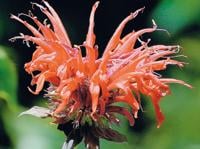If you are into bees, butterflies and hummingbirds, then by all means put the monarda or bee balm species at the top of your must-plant list. I’ve always loved the scarlet bee balm, Monarda didyma, especially when hummingbirds come into feed.
When examined close-up, the scarlet bee balm looks like nature’s version of spectacular fireworks. The last few years however have been like a life lesson as other species have caught my attention with their ability to attract pollinators.
Let’s do a little homework first. Scarlet bee balm, Monarada didyma, is native to much of the Eastern half of the United States and into Canada while the wild bergamont, Monarda fistulosa, is native to all but 2 states. This is a huge range of native geographic adaptability.
The spotted bee balm, known as Monarda punctate, and Lemon bee balm, Monarda citriodora, though not as popular, are nevertheless native and true champions in the world of pollinators. The spotted bee balm, I’ll admit, is not as showy as the others, but our 8-foot-by-6-foot clump in the Cottage Garden of the Coastal Georgia Botanical Gardens in Savannah, seems like the Serengeti of bees, butterflies and hummingbirds.
Ours has light pink bracts and yellow flowers, but you’ll find a range of colors — white, green, pink, purple and yellow. As you look at it, you’ll feel a little daunted at trying to shoot a photo with what seems like more than a thousand pollinators buzzing all about. How do you focus? They are everywhere.
I have seen very few plants bring in pollinators in such numbers. The flowers are sweetly fragrant and reach about three feet tall. In this section of the Cottage Garden one might think it is a bee, butterfly and hummingbird sanctuary as we are also growing Little Red Joe Pye weed, Blue Boa agastache, Golden Lace patrinia, Brazilian Button Flower, and Spicy Jatropha. It is indeed like going on safari when you have your camera and close-up binoculars.
The spotted bee balm is perennial and cold hardy from zones 3-9. It may be easier to find online or mail order than at your garden center. If you have a garden center specializing in natives, then you may be in luck.
Like most monarda the best performance will be in well-drained soil. Though we have proven they will thrive in full sun, a little afternoon shade is certainly tolerated. After you plant, apply a good layer of mulch to help conserve your moisture. You will relish the fact that it is another plant that is deer resistant.
Though we have ours in the Cottage Garden, you’ll love it at the woodlands-edge-type bed, backyard wildlife habitat or in just an old-fashioned perennial garden. Try combining with other silver- to gray-foliaged plants such as rose campion, Lychnis coronaria, blue mealy cup salvias like Victoria Blue or the new indigo spires selection Mystic Spires Blue. It will also partner well with the violet-colored Mexican bush sage Salvia leucantha and as mentioned with any of the Joe Pye Weeds. Like the other monardas, this one, too, can be used to make herbal teas.
As you are shopping, keep your eyes also open for the Lemon bee balm or horsemint, Monarda citriodora. It too is native over a huge area. It’s showy lavender flowers look so picturesque in a wildflower type setting and will prove to be a delight to pollinators. While the other monardas above are perennials, this one is an annual. Don’t let that that-fool you, though, as it is a reseeding annual or biennial that will develop into colorful colonies. I hope you will make room for monardas of all sorts in your garden, too.
Norman Winter is the author of two books on flower gardens and director of the Coastal Georgia Botanical Garden.









